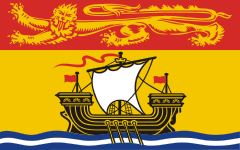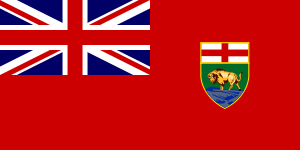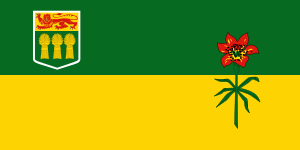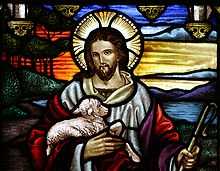The Catholic Church in Canada is part of the worldwide Catholic Church, under the spiritual leadership of the Pope and the Canadian Conference of Catholic Bishops. As of 2008, it has the largest number of adherents to a religion in Canada, with 46% of Canadians (13.07 million) baptized as Catholics. There are 72 dioceses and about 8,000 priests in Canada.
History
Catholicism arrived in Canada in 1497, when John Cabot landed on Newfoundland and raised the Venetian and Papal banners and claimed the land for his sponsor King Henry VII of England, while recognizing the religious authority of the Roman Catholic Church.[1] A letter of John Day states that Cabot landed on 24 June 1497 and "went ashore with a crucifix and raised banners bearing the arms of the Holy Father". In 1608, Samuel de Champlain founded the first Catholic colony in Quebec City. Later, in 1611, he established a fur trading post on the Island of Montreal, which later became a Catholic colony for trade and missionary activity.
In 1620, George Calvert, 1st Baron Baltimore purchased a tract of land in Newfoundland from Sir William Vaughan and established a colony, calling it Avalon, after the legendary spot where Christianity was introduced to Britain.[2] In 1627 Calvert brought two Roman Catholic priests to Avalon. This was the first continuous Roman Catholic ministry in British North America. Despite the severe religious conflicts of the period, Calvert secured the right of Catholics to practice their religion unimpeded in Newfoundland, and embraced the novel principle of religious tolerance, which he wrote into the Charter of Avalon and the later Charter of Maryland. The Colony of Avalon was thus the first North American jurisdiction to practice religious tolerance.[3]
Population
The Roman Catholic population in Canada in 2001[4] and 2011.[5]
| Historical population |
|---|
| Year | Pop. | ±% |
|---|
| 1871 | 1,532,471 | — |
|---|
| 1881 | 1,791,982 | +16.9% |
|---|
| 1891 | 1,992,017 | +11.2% |
|---|
| 1901 | 2,229,600 | +11.9% |
|---|
| 1911 | 2,833,041 | +27.1% |
|---|
| 1921 | 3,389,626 | +19.6% |
|---|
| 1931 | 4,102,960 | +21.0% |
|---|
| 1941 | 4,806,431 | +17.1% |
|---|
| 1951 | 6,069,496 | +26.3% |
|---|
| 1961 | 8,342,826 | +37.5% |
|---|
| 1971 | 9,974,895 | +19.6% |
|---|
| 1981 | 11,210,385 | +12.4% |
|---|
| 1991 | 12,203,620 | +8.9% |
|---|
| 2001 | 12,936,910 | +6.0% |
|---|
| 2011 | 12,810,705 | −1.0% |
|---|
| Province |
2001 |
2011 |
% Change
2001-2011 |
% 2001 |
% 2011 |
 Quebec Quebec |
5,939,715 |
5,766,750 |
-2.9% |
83.4% |
74.5% |
 Ontario Ontario |
3,911,760 |
3,948,975 |
+1.0% |
34.7% |
31.2% |
 Alberta Alberta |
786,360 |
850,355 |
+8.1% |
26.7% |
23.8% |
 British Columbia British Columbia |
675,320 |
679,310 |
+0.6% |
17.5% |
15.0% |
 New Brunswick New Brunswick |
386,050 |
366,000 |
-5.2% |
53.6% |
49.7% |
 Nova Scotia Nova Scotia |
328,700 |
297,655 |
-9.4% |
36.6% |
32.8% |
 Manitoba Manitoba |
323,690 |
294,495 |
-9.0% |
29.3% |
25.0% |
 Saskatchewan Saskatchewan |
305,390 |
287,190 |
-6.0% |
31.7% |
28.5% |
 Newfoundland and Labrador Newfoundland and Labrador |
187,440 |
181,550 |
-3.1% |
36.9% |
35.8% |
 Prince Edward Island Prince Edward Island |
63,265 |
58,880 |
-6.9% |
47.4% |
42.9% |
 Northwest Territories Northwest Territories |
16,990 |
15,755 |
-7.2% |
45.8% |
38.7% |
 Nunavut Nunavut |
6,215 |
7,580 |
+22.0% |
23.3% |
23.9% |
 Yukon Yukon |
6,015 |
6,095 |
+1.3% |
21.1% |
18.3% |
 Canada Canada |
12,936,905 |
12,728,885 |
-1.6% |
43.6% |
38.7% |
The Catholic population underwent its first recorded drop between 2001 and 2011. Notable trends include the de-Catholicization of Quebec, a drop in the Catholic population in small provinces with stagnant populations, and a rise in Catholics in the large English-speaking provinces of Ontario, British Columbia, and Alberta. Canada also receives immigration from Catholic countries, most notably the Philippines, which has kept the Catholic population from dropping in some provinces.
Organization
Within Canada the hierarchy consists of:
There is also a Ukrainian Greek Catholic Archeparchy of Winnipeg, which has suffragan dioceses in Edmonton, New Westminster, Saskatoon, and Toronto.
There are also four other eparchies in Canada:
There is a Military Ordinariate of Canada for Canadian military personnel.
See also
Further reading
- Fay, Terence J. A History of Canadian Catholics: Gallicanism, Romanism, and Canadianism (2002) excerpt and text search
- Johnston, Angus Anthony. A History of the Catholic Church in Eastern Nova Scotia; Volume I: 1611- 1827 (1960)
- Lahey, Raymond J. The First Thousand Years: A Brief History of the Catholic Church in Canada (2002)
- Morice, A G. History Of The Catholic Church In Western Canada: From Lake Superior To The Pacific (1659–1895) (2 vol; reprint Nabu Press, 2010)
- Murphy, Terrence, and Gerald Stortz, eds, Creed and Culture: The Place of English-Speaking Catholics in Canadian Society, 1750 – 1930 (1993)
References
|
|---|
| | Ecclesiastical Province of Edmonton | | |
|---|
| | Ecclesiastical Province of Gatineau | |
|---|
| | Ecclesiastical Province of Grouard-McLennan | |
|---|
| | Ecclesiastical Province of Halifax | |
|---|
| | Ecclesiastical Province of Keewatin-Le Pas | |
|---|
| | Ecclesiastical Province of Kingston | |
|---|
| | Ecclesiastical Province of Moncton | |
|---|
| | Ecclesiastical Province of Montréal | |
|---|
| | Ecclesiastical Province of Ottawa | |
|---|
| | Ecclesiastical Province of Québec | |
|---|
| | Ecclesiastical Province of Regina | |
|---|
| | Ecclesiastical Province of Rimouski | |
|---|
| | Ecclesiastical Province of Saint Boniface | |
|---|
| | Ecclesiastical Province of St. John's | |
|---|
| | Ecclesiastical Province of Sherbrooke | |
|---|
| | Ecclesiastical Province of Toronto | |
|---|
| | Ecclesiastical Province of Vancouver | |
|---|
| | Ecclesiastical Metropolia of Winnipeg | |
|---|
| | Sui iuris Jurisdictions | |
|---|
|
|
|---|
| | Sovereign states | |
|---|
| Dependencies and
other territories |
- Anguilla
- Aruba
- Bermuda
- Bonaire
- British Virgin Islands
- Cayman Islands
- Curaçao
- Greenland
- Guadeloupe
- Martinique
- Montserrat
- Puerto Rico
- Saint Barthélemy
- Saint Martin
- Saint Pierre and Miquelon
- Saba
- Sint Eustatius
- Sint Maarten
- Turks and Caicos Islands
- United States Virgin Islands
|
|---|
|



